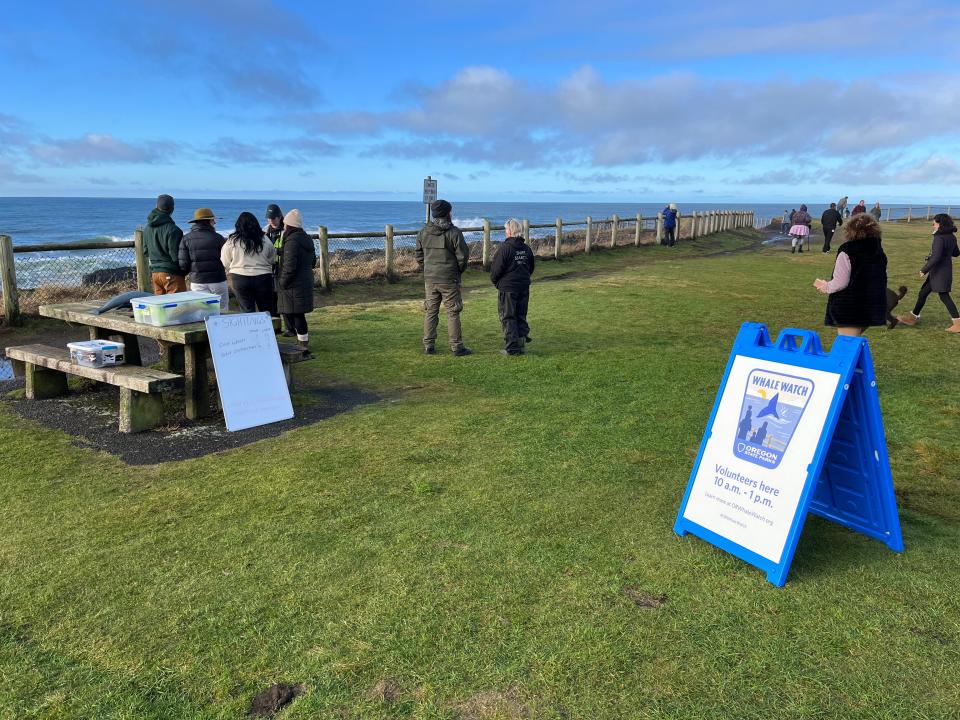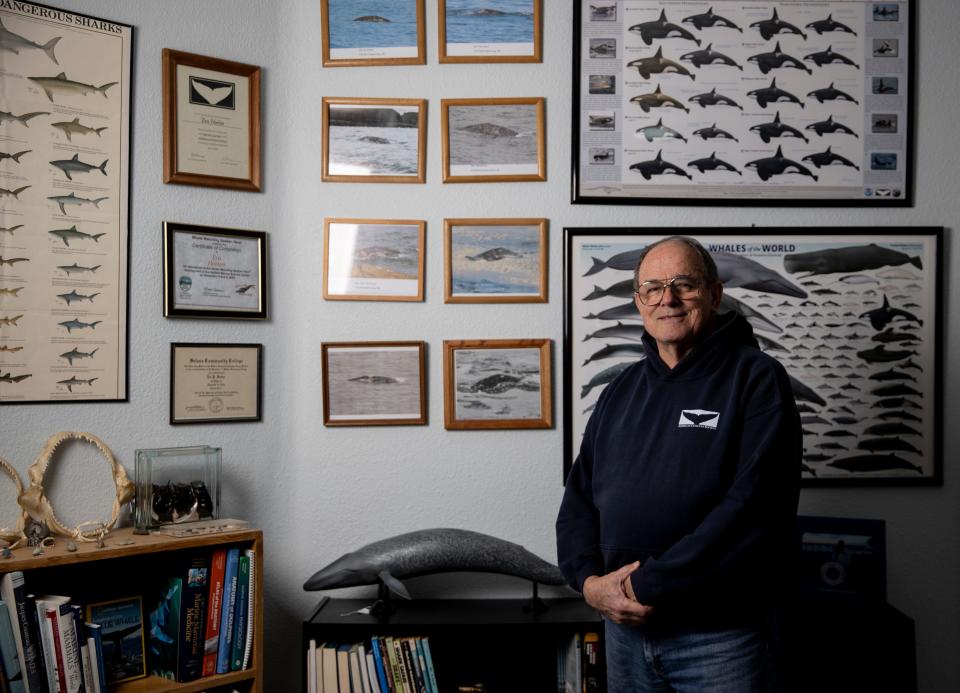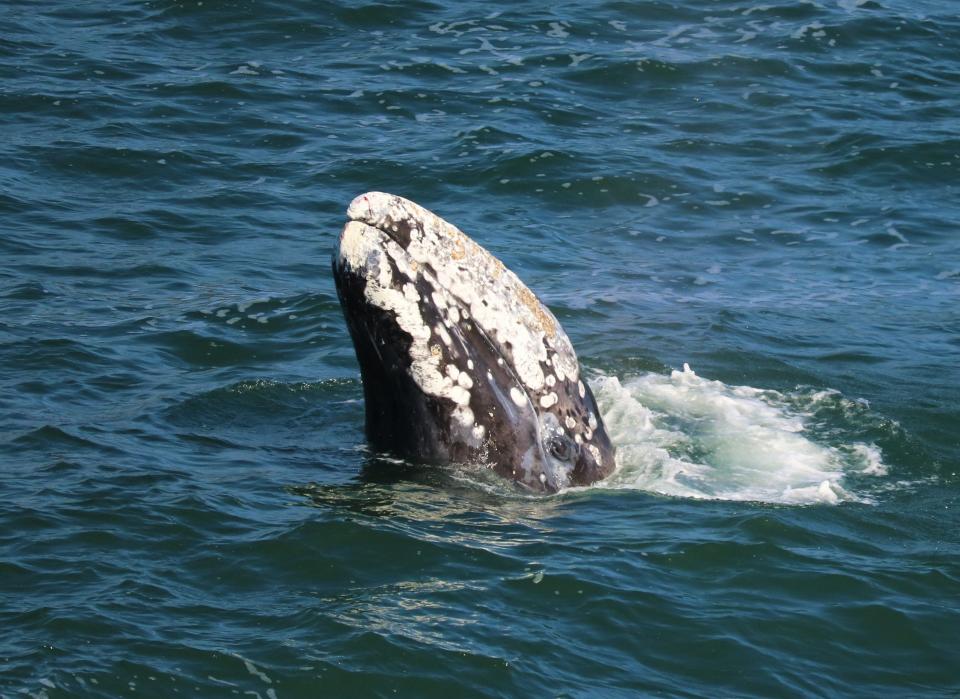Meet our Mid-Valley: Retired firefighter shares passion during Spring Whale Watch Week
This is part of a weekly series introducing readers to individuals who are passionate about our Mid-Valley community.
Framed photographs of Sleepy, Cobra, Ginger, Morisa, Hurricane, Starship, Scarback and Eagle Eye hang on a wall in Era Horton's office. He calls it his hall of fame.
In 14 years as a whale watch volunteer for the Oregon State Parks and Recreation Department, he has spotted those eight grays more than any others.
The photos are part of an extensive collection he has submitted to the Cascadia Research Collective, which maintains an identification catalog for gray whales migrating along the West Coast.
Horton has provided ID photos to the organization, based in Olympia, Washington, for eight years.
He has seen Hurricane 27 times, Eagle Eye 18 times and Scarback eight times. He will be on the lookout for them again during Spring Whale Watch Week on the Oregon Coast.
"Every year, when you know they're getting ready to start showing up here again and you go out and see one, it's like seeing an old friend," Horton said.
Boiler Bay offers unobstructed panoramic view
Trained volunteers like Horton will be stationed from 10 a.m. to 1 p.m. daily March 28 to April 2 at 17 designated locations along the coast to answer questions and help visitors spot whales.
The sites represent some of the best places to go whale watching, from Fort Stevens Park near Astoria to Harris Beach State Park near Brookings.
Volunteers will have a kit with them to help educate visitors, including brochures, sample baleen to touch, and a rope to demonstrate the length of a whale.
Officials expect an estimated 18,000 gray whales to swim past Oregon's shores from late March through June as part of their annual migration from Mexico to Alaska. Oregon State Parks celebrates the reverse migration in late December.

The Whale Watching Center at Depoe Bay is always a hot spot, perched on a seawall with expansive ocean views and a large viewing deck. The center has binoculars for visitors to borrow and displays featuring facts about whales.
Horton is partial to Boiler Bay, where he volunteers during Whale Watch Week. It is about a mile north of Depoe Bay and the nearest volunteer site to his West Salem home, about a 75-mile drive.
Meet our Mid-Valley: Learning patience from Salem's local eagle pairs
Boiler Bay doesn't have a shelter where visitors can take cover from inclement weather like at Depoe Bay, but it does offer an unobstructed panoramic view of the ocean. And there is a restroom.
"We have a point that sticks out not quite a quarter-mile," Horton said. "You're exposed, but it's an awesome viewpoint. I've probably seen 1,500 whales there over the years, including blue whales, humpbacks and minke whales. It's a great spot."
Horton may be as knowledgeable as any volunteer in the program.
He not only has been through its training multiple times, taught by marine biologists, state park rangers and local experts, but taken additional classes on his own.

He is a member of the American Cetacean Society, was certified as a naturalist in 2016, and now teaches the naturalist class for the Oregon chapter. State Parks asked him to be a presenter for last winter's training.
"We have a lot of super knowledgeable volunteers," park ranger Peter McBride said. "He's a great example of somebody who is really excited to share the knowledge. He is definitely very passionate about what he does."
Horton took the same approach during his 36-year career as a firefighter, first in the San Francisco Bay Area, then Central Oregon, and finally at the Department of Public Safety Standards & Training in Salem.
"Whatever I'm involved in, I'm in wholeheartedly," he said. "I'm going to research everything I can, I’m going to read everything I can, and I take classes online all the time."
Distinctive markings lead to names for whales
Horton can tell you all about the anatomy, behavior and migration patterns of gray whales, 90% of what visitors will see on the Oregon Coast.
Gray whales average 40 feet long — about the size of a school bus, is what Horton tells visitors — and weigh an average of 40 tons. They have a dorsal hump and a series of "knuckles" between it and the tail fluke. The tail fluke is nearly 10 feet wide.
Many of the whales have white patches and distinctive markings that earn them a name after numerous sightings.

Hurricane, Eagle Eye and Scarback are good examples. In fact, Horton helped name Hurricane and Eagle Eye. Hurricane has a marking like the hurricane symbol on a weather map.
Eagle Eye is Horton's favorite whale, and the subject of the first identification photo he took in 2009 and would later submit to the Cascadia Research Collective. The organization relies on contributions from citizen scientists like Horton for its research.
Today, he has three five-inch-thick binders full of biographies and photos of identified gray whales in the collective's catalog.
Each entry has a bio page, including what year the whale was born and when it first was first seen, the name of its mom, and if it has been with a calf. On the opposite page are two dated images, one showing the whale's left dorsal hump and the other its right dorsal hump.
Horton tries to capture both whenever he spots a whale, but it can be challenging.
"Some are better than others because whales don't pose for you," he said.
Each whale has an ID number, not just a name. Some are known by different names in different areas, so it prevents confusion. Eagle Eye is known as Batman in some parts. His ID number is CRC-107. He was born in 1994.
Scarback is easy to recognize because of the never-healing wound on her back. She also is known by the name Scarlett, her ID number is CRC-204, and she has had seven calves.
"She is our most famous whale," Horton said. "She is known up and down the West Coast."
Scarback is believed to have been disfigured in the 1980s, most likely by a ship strike or an exploding harpoon.
"The red is not blood or anything," Horton said. "Those are whale lice that keep all the dead tissue cleaned out."
Be on the lookout for spy-hopping and sharking
Volunteers keep a count during Whale Watch Week and submit a report at the end of each day. Horton keeps a clicker in each pocket, the one on his left for whales and the one on his right for people.
He said visitors are apt to see more whales closer to shore and breaching in the spring than in winter.
"I’ve been hit with blows on shore; they're that close," Horton said.
He estimates anywhere from 50 to 100 gray whales can be spotted in a week at Boiler Bay. The most he has seen in a three-hour volunteer shift there is 37.
The ultimate in whale sightings is a breach, when a whale propels most of its body out of the water.
"That's what everyone wants to see," Horton said.
Gray whales, however, are not as demonstrative as other whales, such as humpbacks.
Other interesting movements to be on the lookout for include spy-hopping and sharking.
Spy-hopping is when a whale lifts its head straight out of the water to inspect its surroundings. Sharking is when a whale turns on its side in shallow water while feeding on the bottom, and the triangle of its tail fluke resembles a shark fin.
Horton often has binoculars or a camera in hand, hoping to capture a breach or a whale he has never seen. He uses a DSLR camera with a 250mm telephoto zoom lens.
On occasion, he misses a great photo opportunity while talking to visitors. Once, he saw two gray whales taking turns breaching. The fourth time they breached side by side.
"I have to remind myself sometimes to put the camera down and soak it in," he said.
Opening doors and healing wounds
Whale watching is more than just a two-week hobby for Horton. His love of science goes back to when he was a teenager, and he has always had an affinity for the ocean.
He started his firefighting career in the Bay Area and lived about an hour's drive from the ocean. He and his wife, Toni, spent a lot of time there with their three children. They saw their first whale at Point Reyes Peninsula.
"It was right below us, the point and the lighthouse, and we could see the whole whale as it came up to breathe," Horton said. "That was the coolest thing in the world."
Now he gets to watch others experience that moment.
"I dealt with people on the worst day of their life for 36 years," Horton said. "Now I deal with people who are enjoying the coast, and most of them are seeing a whale for the first time. It's not on TV. It's not on National Geographic. It's live.
"And to hear an adult scream and holler and jump up and down, that brings me back. It's addicting."
Being a whale watch volunteer has provided Horton with other opportunities.
In addition to taking ID photographs, he has spotted whales for an Oregon State University researcher and been involved with production of an episode for the Disney+ National Geographic documentary series "America the Beautiful."
A crew interviewed him at his home for a couple of hours one day and spent six hours with him on the coast another day. The episode is called "Brave New World" and premiered last summer. He said his part is in the second half of the episode.
Whale watching also has been therapeutic for Horton, helping him heal from PTSD he developed during his firefighting career. He lost two friends in the field and had two haunting calls early on.
He helped rescue two people from a submerged car on a New Year’s Eve on one call but couldn't save the lives of two boys, the same age as his sons, from a house fire on another.
"Being a first responder all your life and the things you see, they don't go away," Horton said. "I had some issues for a while, but it's gotten easier. I can talk about the incidents without choking up too much."
How to become a volunteer
State Parks has about 150 volunteers for its whale watch program, down from about 300 before the pandemic. If you are interested in becoming a volunteer, visit Orwhalewatch.org.
The next volunteer training won't be until early December, but there are steps you can take now to prepare.
If you have an idea for someone we should profile for this series, please email Statesman Journal senior news editor Alia Beard Rau at arau@gannett.com
Capi Lynn is the Statesman Journal's news columnist. Send comments, questions and tips to her at clynn@statesmanjournal.com or 503-399-6710. Follow her work on Twitter @CapiLynn and Facebook @CapiLynnSJ.
This article originally appeared on Salem Statesman Journal: Meet our Mid-Valley: Retired firefighter shares whale watching passion

